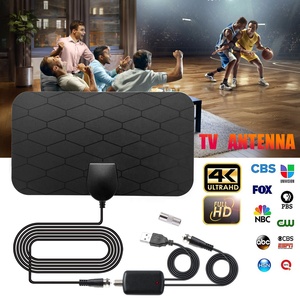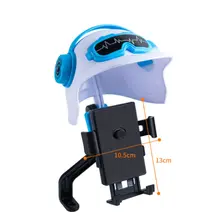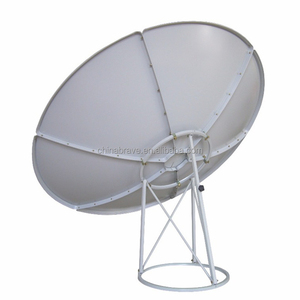What is 150cm Satellite Dish
A 150cm Satellite Dish is a large, parabolic antenna designed for the reception of satellite television signals. These signals are typically transmitted from geostationary satellites orbiting the Earth, allowing viewers to access a wide array of television channels, including news, sports, movies, and entertainment from around the world. The dish's size, 150cm in this case, refers to the diameter of the dish, offering a larger surface area to capture signals over greater distances.
This equipment is essential for individuals and businesses that wish to access a broad selection of satellite TV channels. It's particularly useful for those living in remote areas where terrestrial broadcasting may not reach or where cable infrastructure is limited. The 150cm Satellite Dish's design enables it to operate effectively within the Ku and C bands, which are commonly used for satellite television transmission.
The working principle of a 150cm Satellite Dish involves the reflection of signals from the orbiting satellite's transponder to the dish's surface. The curved shape of the dish focuses incoming signals onto a receiver that converts them into audio and video for a television set. The size of the dish plays a crucial role in the quality of signal capture and the range over which it can operate effectively.
Types of 150cm Satellite Dish
The 150cm satellite dish comes in different varieties to suit various requirements and applications:
-
Standard Ku-band Dish: This is one of the most common types of satellite dishes used for both residential and commercial purposes. It typically features a parabolic shape with a focus point that aligns with an LNB to optimize signal reception. They are widely used for receiving signals from satellites that broadcast in the Ku-band.
-
Offset Satellite Dish: The offset dish is similar to the prime focus satellite dish but with its axis of symmetry (the part that divides the dish into two equal halves) positioned to the side rather than at the center. This allows for less interference from adjacent satellites and provides a clearer signal path, which is beneficial in areas where satellite dishes are close together.
-
Motorized Satellite Dish: Designed for regions where a wide range of satellite coverage is desired, motorized dishes can be automatically repositioned to different satellites, offering viewers an extensive selection of channels from around the globe.
-
Portable Satellite Dish: These are smaller, lightweight, and often battery-powered, making them ideal for travelers or those who wish to set up a temporary satellite connection in various locations.
-
Free-to-Air (FTA) Satellite Dish: FTA dishes receive unencrypted satellite transmissions, providing access to free-to-air channels without a subscription or fee. They are popular among international viewers who want to enjoy a variety of foreign channels without the monthly cost.
How to choose 150cm Satellite Dish
When selecting a 150cm satellite dish for business use, it's important to consider several factors:
Firstly, assess the required reception capabilities based on the satellite you intend to receive signals from. For instance, if you need to pick up broadcasts from multiple satellites or require specific programming from one satellite, you'll need a motorized dish that can be aimed at different orbital positions.
Material durability is another key consideration; steel or galvanized steel dishes are robust and suitable for long-term outdoor use, while plastic or aluminum options might be more cost-effective for temporary setups or lighter use.
The mounting type is also crucial—pole mounts are common for residential applications, while ground mounts may be preferable for commercial use where stability is paramount.
Lastly, consider environmental factors such as color (for aesthetic integration), polarization options (vertical for Ku-band signals), additional features like foldability (for ease of storage and transportation), and connector types (for varied LNB options).
About 150cm Satellite Dish on Alibaba.com
Alibaba.com stands out as a leading global marketplace that helps businesses source commercial products, including an extensive range of 150cm satellite dishes suitable for various professional applications. Whether you're in need of robust equipment for your broadcasting company or reliable systems for your rural telecommunication needs, Alibaba.com connects you with suppliers who offer products designed to meet diverse commercial requirements.
The platform's user-friendly interface allows you to filter search results by material, color, connector type, polarization, and other specifications—streamlining the selection process. Additionally, with features like Trade Assurance, you can transact with confidence knowing your payments are protected until your order is safely delivered.
Leveraging Alibaba.com's global reach and comprehensive product listings can give your business a competitive edge by ensuring you have access to top-tier satellite communication solutions no matter where your operations take you. The platform's commitment to facilitating easy international trade is evident through its multilingual support and mobile-friendly shopping options—making it simpler than ever to connect with suppliers and fulfill your business’s unique requirements.
Common FAQs for 150cm Satellite Dish
What is the difference between a Ku-band and an LNB?
Ku-band LNBs are designed to receive signals in the higher frequency range above 10 GHz, allowing for more data to be transmitted. LNBs are typically used for satellite TV reception due to the higher frequency bands they operate in.
How do I know if a satellite dish is compatible with my TV receiver?
Check the specifications of your TV receiver for compatibility with satellite dishes. Look for information about the frequency bands it can receive (Ku-band, C-band, etc.) and the type of connectors it uses (F, F, F, etc.) to ensure a proper connection.
What should I consider when choosing the material of a satellite dish?
Material choice, such as steel, aluminum, or plastic, should be based on your specific needs. Steel is durable and suitable for harsh weather conditions, while aluminum is lighter and more manageable for DIY installations on structures.
Can I use a satellite dish for both TV and internet services?
Yes, you can use a satellite dish for both TV and internet services. However, it's important to ensure that the dish is designed for internet use with features like Wi-Fi connectivity if needed.
Are there portable satellite dish options available for businesses?
Yes, there are portable satellite dish options available that are lightweight and easy to set up, suitable for businesses that require mobility or have temporary setups in locations without fixed infrastructure.
What mounting types are available for satellite dishes?
Satellite dishes come with various mounting types including wall mounts, pole mounts, and ground mounts. The choice depends on the intended use and the area where the dish will be installed.
How do I ensure I'm purchasing a high-quality satellite dish?
Look for features like 'sat-foldable' which indicates the dish can be compacted for storage or transport when not in use. Additionally, check the material quality and brand reputation.
Is it possible to get a customized satellite dish with specific features?
Many suppliers offer customization options for satellite dishes, such as specific sizes, colors, or additional functionalities like built-in motors or special mounting requirements.
How do I know if I need a single or multiple LNB setup for my satellite dish?
Consider the number of receivers or channels you need to accommodate. A single LNB setup is sufficient for one receiver, while multiple LNB setups support more receivers and channels, which is ideal for commercial or multi-room setups.
What should I look for in a satellite dish if I want to use it for broadcasting services?
For broadcasting services, look for high-quality, professional-grade dishes with a proper design for efficient signal reception. Consider the frequency bands and connector type to ensure it aligns with your service needs.
Can I use a satellite dish designed for TV reception with a different system such as IPTV?
It depends on the compatibility of the system. Some satellite dishes are designed for specific TV systems (like DVB-S or DVB-T), while others may be used across different systems. Check the specifications to ensure compatibility.












































 浙公网安备 33010002000092号
浙公网安备 33010002000092号 浙B2-20120091-4
浙B2-20120091-4